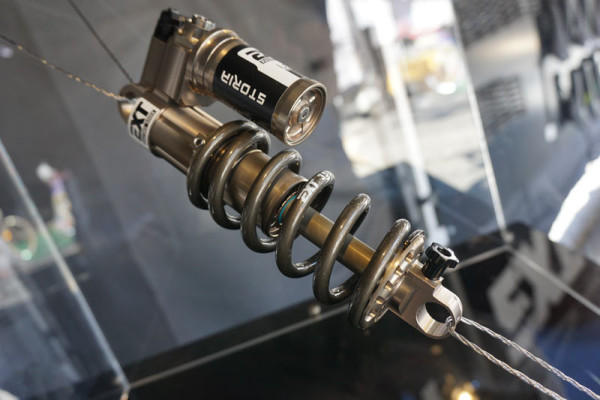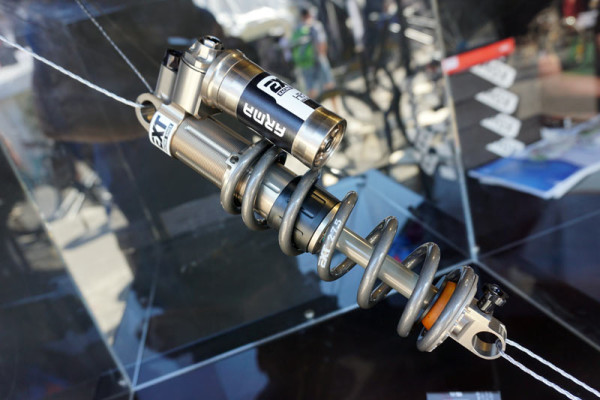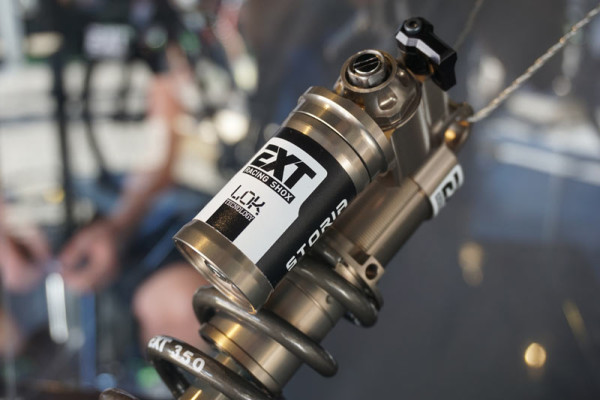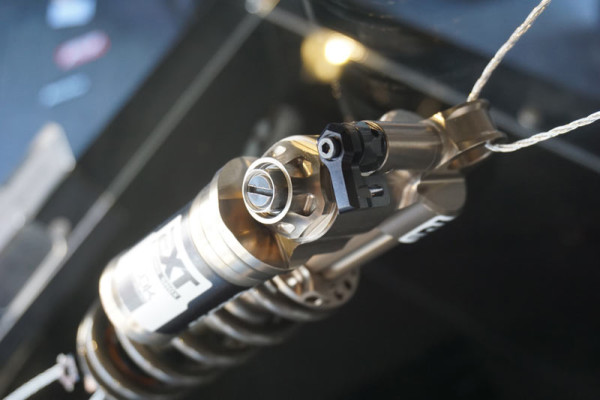The shocks you’re seeing here aren’t entirely new, they’ve been on the market for a few years, but it’s the first time we’ve seen them. And there are a few new features for 2015/16. After diving into the tech, they’re worth a good hard look the next time you’re considering upgrading your rear shock.
Extreme Racing Shox are made in Italy of alloy, chromoly steel and titanium with ultra fine tolerances. The beautifully polished exterior is only the icing on the cake. Inside are special sealing systems that take advantage of their extremely low pressure nitrogen chamber that backs up the damping fluid. The result is a super smooth shock that reacts almost immediately to the slightest input forces, giving you better traction and more predictable performance across the entire range.
The damping technology is unlike anything you’ll find on other bicycle suspension components, borrowed almost perfectly from the company’s F1 experience. Put it altogether and you’ve got an extremely high end shock that’s customized for you and your bike, is lightweight, and isn’t much more expensive than what’s already on top level bikes…
Two models are available, the Arma for downhill bikes, and the Storia for enduro and trail bikes. Each one is tuned specifically for you, your riding style and your bike, taking wheel size, leverage ratio and suspension design into consideration. After filling in a questionnaire, the brand tunes the damping characteristics and spring weight just for you, then sends it along with two different coils to ensure you’ve got exactly what you need.
The shocks have been on the market for a few years with three external adjustments on each: Rebound, plus high and low speed compression. Now, they’ve added a hydraulic bottom out adjustment to the Arma, and a lockout lever to the Storia. The black dial just above the piggy back reservoir on the Arma shown above is the hydraulic bottom out dial and gives you control over the compression rate at the very end of the stroke.
Assisting that is a minimal 6mm bottom out damper, which they say is less than half the height of most other brands’ bumpers, letting you use virtually all of the travel before it saves the day.
The Storia adds a lockout lever in the same spot, useful for longer climbs or sprints.
The compression adjustments sit just below it, with the inner dial giving you 11 clicks of low speed adjustment and outer 16 clicks of high speed. At the base of the shock, near the lower eyelet, is a 10-click rebound adjustment.
The original designs are without the additional HBO or lockout controls.
But, they do provide external nitrogen charge valves. Best bet is to leave that adjustment to the pros, though, unless you have a clean room and a nitrogen charging station.
It’s the nitrogen charge, though, that’s one of the special features of these shocks. Where most brands run up to 300psi behind the IFP, Extreme Shocks runs just 30-35psi. The IFP, or Internal Floating Piston, is what separates the nitrogen charge from the hydraulic damping fluid. The higher the charge, the tighter the piston’s seal must be, which means higher friction. The pressure is there to push back against the fluid and help move it through the rebound circuit, but higher pressure means it takes more force to start moving it as the shock begins to compress. By using a very low pressure system, the seal can be lighter and the shock can start moving more easily. Result: better small bump compliance.
Another big difference? They use F1-inspired spool valves inside rather than the traditional damping controls like shims. Those require no seals or shims and extremely low hysteresis. Translation: Extremely low inertia to overcome and less internal friction. Add in a proprietary low friction nickel plating and Energize seal on the shaft and you end up with very quick movement over the smallest bumps.
Spend the time to get your external controls set correctly and they say it’ll let you run more precise tire pressures. And they do recommend making plenty of practice runs to get all those variables right, even so far as testing different pressures for the different tires you’d run in different weather and trail conditions. You know, kinda like the pros do. Combine it all and you should end up with insane traction in any condition and on any terrain.
The last bit of sizzle for the shocks is the weight: The body weight of the Arma is 450g (241x76mm) and the Storia is 430g (222x69mm). Add in their custom lightweight steel springs and package weights go to about 600-620g. Springs are available in 25lb increments with a wide range to suit any weight rider and bike.





